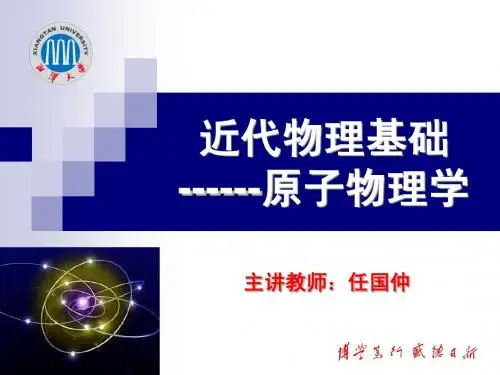第3章 氢分子离子的量子力学处理模版范本
- 格式:ppt
- 大小:906.00 KB
- 文档页数:33
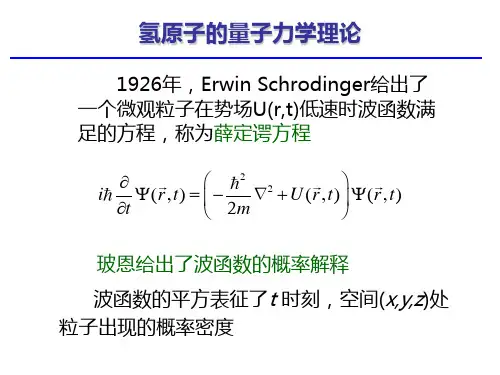
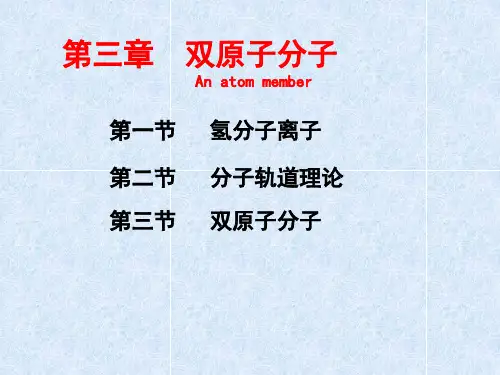
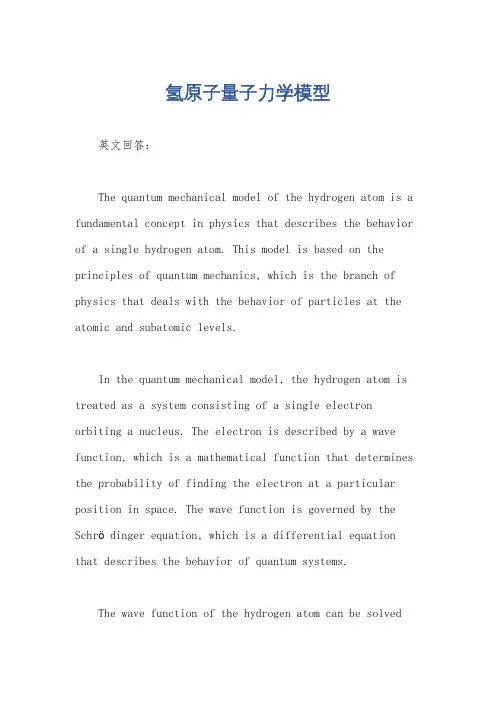
氢原子量子力学模型英文回答:The quantum mechanical model of the hydrogen atom is a fundamental concept in physics that describes the behavior of a single hydrogen atom. This model is based on the principles of quantum mechanics, which is the branch of physics that deals with the behavior of particles at the atomic and subatomic levels.In the quantum mechanical model, the hydrogen atom is treated as a system consisting of a single electron orbiting a nucleus. The electron is described by a wave function, which is a mathematical function that determines the probability of finding the electron at a particular position in space. The wave function is governed by the Schrödinger equation, which is a differential equation that describes the behavior of quantum systems.The wave function of the hydrogen atom can be solvedanalytically, resulting in a set of wave functions called the hydrogen atom orbitals. These orbitals describe the different energy levels and spatial distributions of the electron in the hydrogen atom. The lowest energy level is called the ground state, while higher energy levels are called excited states.Each orbital is characterized by a set of quantum numbers, which specify the energy, shape, and orientation of the orbital. The principal quantum number (n) determines the energy level of the orbital, with larger values of n corresponding to higher energy levels. The azimuthal quantum number (l) determines the shape of the orbital, with different values of l corresponding to different shapes such as s, p, d, and f orbitals. The magnetic quantum number (m) determines the orientation of theorbital in space.For example, the 1s orbital is the ground state orbital of the hydrogen atom, with n=1, l=0, and m=0. This orbital is spherically symmetric and has the lowest energy level. The 2s and 2p orbitals are examples of excited stateorbitals, with n=2. The 2s orbital is spherically symmetric like the 1s orbital, while the 2p orbitals have different shapes and orientations.The quantum mechanical model of the hydrogen atom provides a detailed understanding of the behavior of electrons in atoms. It explains phenomena such as the quantization of energy levels, the stability of atoms, and the formation of chemical bonds. This model has been successful in predicting and explaining a wide range of experimental observations in atomic physics.中文回答:氢原子的量子力学模型是物理学中的一个基本概念,描述了单个氢原子的行为。



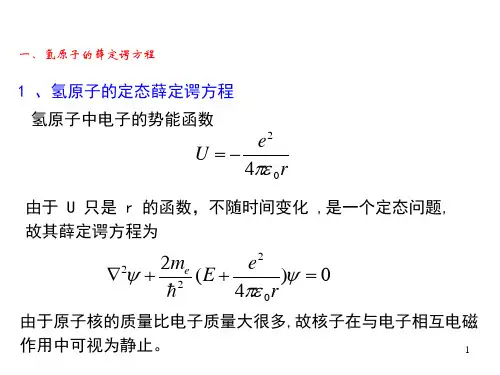
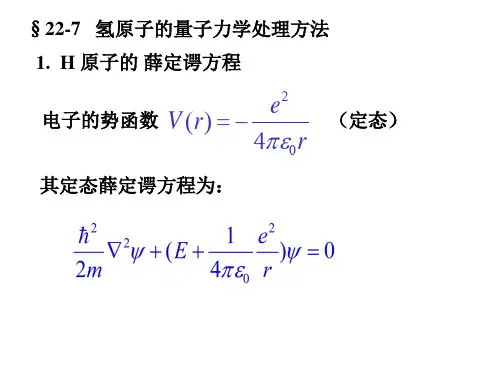

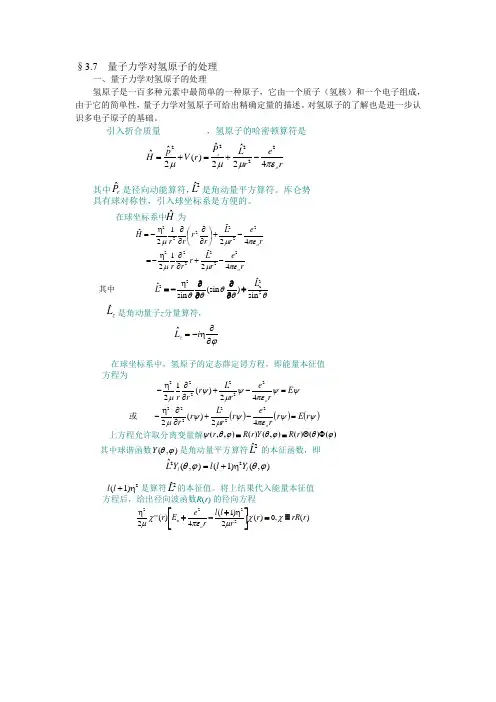
§3.7 量子力学对氢原子的处理一、量子力学对氢原子的处理氢原子是一百多种元素中最简单的一种原子,它由一个质子(氢核)和一个电子组成,由于它的简单性,量子力学对氢原子可给出精确定量的描述。
对氢原子的了解也是进一步认识多电子原子的基础。
引入折合质量,氢原子的哈密顿算符是re r L P r V p H o r πεμμμ42ˆ2ˆ)(2ˆˆ22222-+=+=其中是径向动能算符,是角动量平方算符。
库仑势具有球对称性,引入球坐标系是方便的。
r P ˆ2ˆL 是角动量子z 分量算符,re r L r r r re r L r r r r H o o πεμμπεμμ42ˆ1242ˆ12ˆ222222222222-+∂∂-=-+⎪⎭⎫ ⎝⎛∂∂∂∂-= θθθθθ22z 22sin ˆ)(sin sin ˆL L +∂∂∂∂-= 其中在球坐标系中为Hˆz L ˆϕ∂∂-= i L zˆ在球坐标系中,氢原子的定态薛定谔方程,即能量本征值方程为上方程允许取分离变量解:其中球谐函数是角动量平方算符的本征函数,即是算符的本征值。
将上结果代入能量本征值方程后,给出径向波函数R (r ) 的径向方程()()()ψψπεψμψμψψπεψμψμr E r re r r L r r E re r L r r r o o =-+∂∂-=-+∂∂-42)(242)(12222222222222 或)()()(),()(),,(ϕθϕθϕθψΦΘr R Y r R r ==),(ϕθY 2ˆL ),()1(),(ˆ22ϕθϕθl l Y l l Y L +=2)1( +l l 2ˆL)(,0)(2)1(4)(''22222r rR r r l l r e E r o n ≡=⎥⎦⎤⎢⎣⎡+-+χχμπεχμ一些径向波函数R n,l (r )的表达式:一些球谐函数Y l,m 的表达式:该方程给出能量的本征值221)(21nc E n αμ-=111212311,2212310,22310,12131)(21212)(12)(a ra ra r e e a r a r R a r a r R ear R ---⎪⎪⎭⎫ ⎝⎛⎪⎪⎭⎫ ⎝⎛=⎪⎪⎭⎫ ⎝⎛-⎪⎪⎭⎫⎝⎛=⎪⎪⎭⎫ ⎝⎛=θπθπθππϕϕcos sin sin ,,,,4383832101111100====--Y e Y e Y Y i i (,)θϕ以上计算表明,波函数是力学量算符集合的共同本征函数,即可见三个量子数n,l,m 与状态Ψn,l,m 有一一对应关系,为了简单,我们常用量子数(n,l,m )表征量子态Ψn,l,m 。
